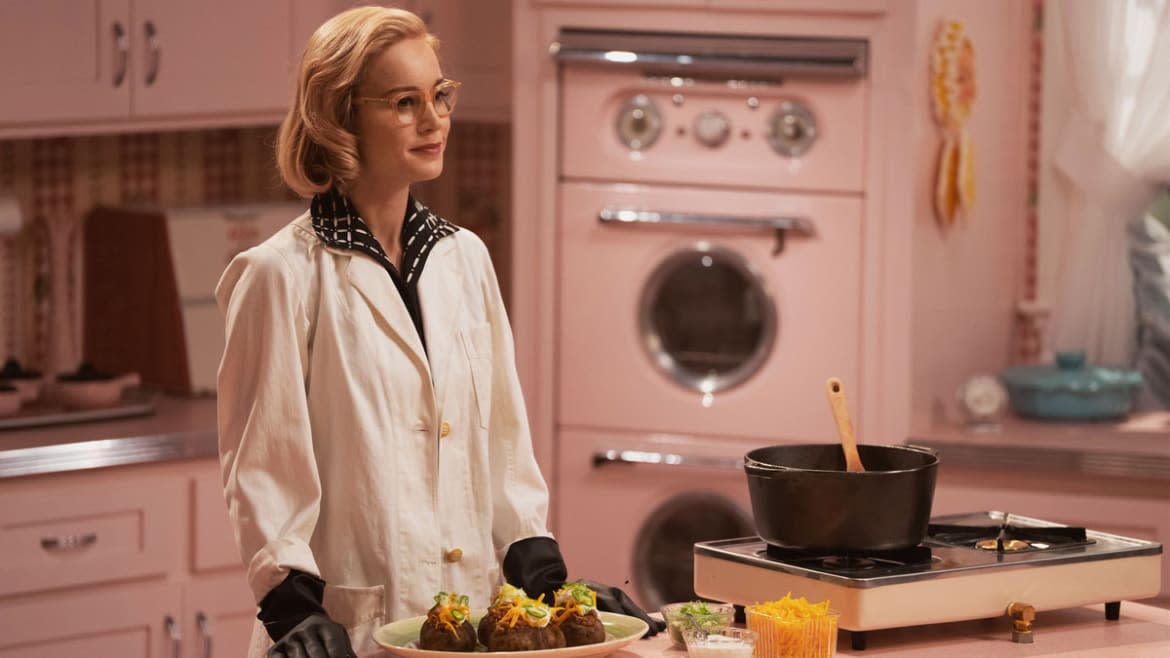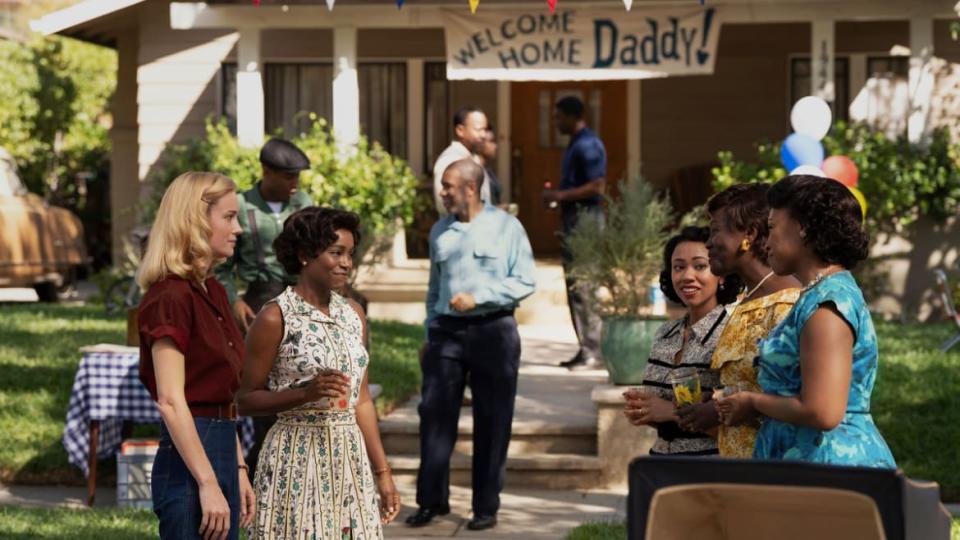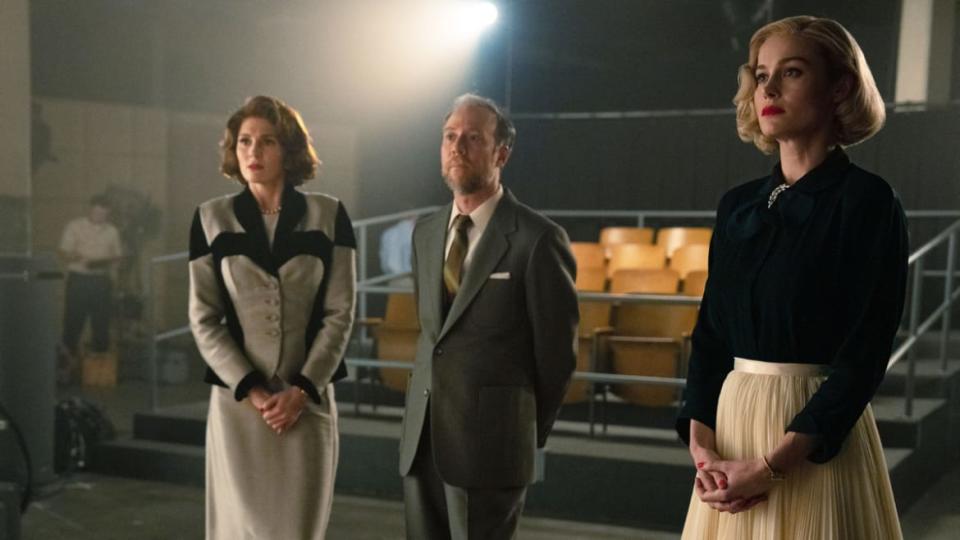The ‘Lessons in Chemistry’ Team Was Nervous About Adapting the Bestseller

Lessons in Chemistry was practically born to become a TV series. Before Bonnie Garmus’ scientific foodie romance novel even hit shelves, Apple TV+ locked down a deal with star Brie Larson to recreate the brilliant novel in a mini-series. Everyone involved had the right idea: After the book debuted in March 2022, it hit the NYT Bestsellers list, skyrocketed in popularity on BookTok, and was later named Barnes & Noble’s 2022 Book of the Year.

For series creator Lee Eisenberg and director Sarah Adina Smith—who worked alongside Garmus, a co-executive producer, to adapt the show—these accomplishments should have given them even more confidence in their adaptation. The pair had signed onto a project not knowing how popular the book might become, and, luckily, it turned out to be a massive hit. But with a huge, passionate fanbase, bringing the world of Lessons in Chemistry to life became a daunting task.
“I’d never adapted anything before, so I was going in a little bit, uh, blissfully ignorant,” Eisenberg tells The Daily Beast’s Obsessed over Zoom. “The pressure of working on something that is so beloved—also by me and my family—it wasn’t a casual thing.”
“You didn’t want to let down your wife,” Smith corrects him. “Let’s be honest.”
“Yeah, it really comes down to my wife,” Eisenberg says with a laugh. “My wife read it first, just so we’re clear. She said, ‘You need to call Apple.’ I listened to my wife, and here we are!”

Indeed, listening to women is the best thing one can do, both in the real world and in the universe of Lessons in Chemistry. Set in the 1950s and ’60s, the series follows chemist Elizabeth Zott (Larson) as she falls in love with her brilliant coworker, Calvin Evans (Lewis Pullman), hosts her very own science-themed cooking show called Supper at Six, and pushes against the evil (usually white male) forces of the world. Devout fans of the novel should know upfront: The series is just as clever, touching, and delicious as Garmus’ novel.
Below, Smith and Eisenberg chat about why Larson was the perfect collaborator on Lessons in Chemistry, creating the delectable set of Supper at Six, and whether or not a second season is on the horizon.
(Warning: Slight spoilers for the plot of Lessons in Chemistry below.)
This show came together so fast—I was still finishing the book when the first look dropped. Was that a goal, to turn it around quickly?
Lee Eisenberg: The development of [this project] was happening in concert with the book becoming what it eventually became. I had read the book and just fell in love with it for all of the reasons that everyone else in the world has fallen in love with it. I put in an incoming call to Apple, which I’ve never done before! Usually, material comes to me and Sarah, and people say, “Hey, would you consider working on the show?” With this one, I was like, “Hello! I would like to be on your show! Please! If there’s anything I can do!”
Sarah Adina Smith: I do think it worked to the show’s benefit that we were beholden to Brie’s very busy schedule. That probably helped catalyze it and get it going faster than it might have [otherwise].
What was the hardest part about the adaptation process?
Eisenberg: There was definitely a pressure that so many people felt such a connection to the material and to Elizabeth as a character. I wanted to honor that and not blow it. I didn’t want to do anything that would feel less than the book in any way. There was such a high bar from the book that it was really scary. The book just touches on so many different things and there’s so many twists and turns. I wanted to leave myself the opportunity to truly adapt it, but also honor it, so that the fans of the book didn’t feel like, “What did you do with my dear beloved book?”
Smith: I feel like, when you read a book, it exists in your imagination. Oftentimes, you don’t read it all in one sitting. It’s over a period of time. There’s pacing and your mind has time to digest it, it has time to evolve and grow in your mind. One thing I was aware of was wanting to shoot the show with a rhythm and pace that allowed for some negative space as well. Normally, in TV and film, you gotta keep it moving. But I wanted to shoot it simply with not too many cuts, in a way that could allow the audience to put themselves into it.
Eisenberg: By shooting the first two episodes as a block, [Smith] really established a look and a tone for the subsequent six episodes. The pace of the dialogue and the way that Sarah shot it, we were able to live in the scenes really well. The show always felt like there was movement. There was an initial fear when we first got into it, like, how do you make two people in a lab shaking beakers and making sure that a clear one turns into a foggy substance compelling for an audience?

Then there’s Supper at Six, which was just marvelous to watch. Did you reference any specific cooking shows while creating that show-within-a-show?
Smith: We had a lot of fun with 1950s cuisine. American 1950s cuisine is not known to be super great and delicious. Something we talked about a lot is in World War II, women were oftentimes supporting their families and getting out of the home and then, all of a sudden, the men come back from war and [the women] are pushed back into the kitchen. A lot of 1950s cuisine was designed as a way to give women convenience and to give them back some of that freedom that they had lost.
What I think is really interesting is Elizabeth is a little bit ahead of her time, she sort of has modern, more fresh and delicious twists on 1950s cuisine. She’s still very respectful of the idea that women need to find a way to feed their families on a budget, keep them healthy, and have a life of their own.
Speaking of Elizabeth, let’s talk about Brie. How did she contribute as an executive producer?
Eisenberg: Brie is not an executive producer in name only. Brie was very much our partner in this. She was involved in pre-production, walking sets and talking about the color palette for Supper at Six. She was instrumental in the evolution of Elizabeth’s wardrobe throughout the show. Courtney McBroom, our food stylist, is one of Brie’s best friends, so they worked together on those dishes. Brie did it all. She really wore so many hats—to the point where I would say to her, “I don’t think you need to be in the pre-call for the main titles. We’ve got this one. You should act for today.”
How Brie Larson’s ‘Captain Marvel’ Made Angry White Men Lose Their Damn Minds
Smith: Just to give you one little anecdotal example, there was one scene where she was wearing these really uncomfortable shoes from the 1950s, and I needed her to run down some stairs and through a crowd of people and it was taking us several takes to coordinate. Around take four or five, I noticed blood coming through her white ’50s socks in the back. I was like, “Okay, medic! Stop. We need to get a bandage here.” And she was like, “No, just roll it again. We’ve got it this time. I’m fine.” That’s just Brie for you. She has a rigorous commitment to joy and to process. She would hold card games with the other cast members in between set ups.
A lot of readers love the chemistry between Elizabeth and Calvin, but I was really touched by her relationship with Mad (Alice Halsey), their daughter. How did Brie and Alice connect on set?
Eisenberg: [Brie] really developed an amazing relationship with Alice. There was no affect to it. They just would sit around and speak French to one another. Alice’s family would come around, and they all developed a real [bond]. They went dancing together on the weekend. It was not a professional thing where they say “Hi” in the mornings, and then in the afternoons they say “Goodbye!” They really made it feel like a family.
In the show, Elizabeth Zott becomes this somewhat maligned feminist celebrity, which Brie Larson has a bit of a history with, thanks to the misogynistic trolls who hated Captain Marvel. Did you ever make that connection when writing Elizabeth?
Smith: I think it kind of went unspoken. I don’t know if we were directly trying to tell that particular story about [Brie’s] life, but it’s in the zeitgeist, and there’s some subtext in terms of perhaps why she was drawn to this character and one of the things she may have wanted to explore. I certainly don’t want to speak for her about that, but it’s interesting that you point it out.

The show is dealing with gender politics in the 1950s and ’60s that somehow still feel relevant today. Why do you think that is?
Eisenberg: From the beginning, we never set out to make a show that was political with a capital P. Everything was in service of the character. We talked about all of those things, but really, we want characters to go on a journey. Those experiences inform that journey. An example of that is in Episode 1, when Calvin and Elizabeth are walking down the hall and he says, “Why would anyone make a judgment on someone’s talent based on something as non-determinative as gender?” She stops him and she says, “Calvin. How many female scientists can you name aside from Marie Curie?” He just stops, and she goes, “There you go.”
As much as society has evolved and there has been tremendous progress from the 1950s to today, there’s so much more that needs to happen. In these moments, hopefully, the audience stops in their tracks and says, “Oh, right.” It’s a story of white male privilege without stopping to do an entire episode that feels like an after school special about privilege. Elizabeth, our heroine, she’s faced with obstacle after obstacle throughout the city. We watch her come to discover her white female privilege.
This series really runs the gamut of the book, but do you see a Season 2 on the horizon?
Eisenberg: Brie has done quite well for herself living in the Marvel Cinematic Universe, so if there ever was an opportunity to create the LICCU, the Lessons in Chemistry Cinematic Universe, [we’d do it]! [Laughs] We do not have any ideas as of yet, and we feel that the story was complete. But if it made sense to continue telling Elizabeth and Mad and Harriet’s stories going forward, I think we would all jump at the opportunity.
Get the Daily Beast's biggest scoops and scandals delivered right to your inbox. Sign up now.
Stay informed and gain unlimited access to the Daily Beast's unmatched reporting. Subscribe now.


